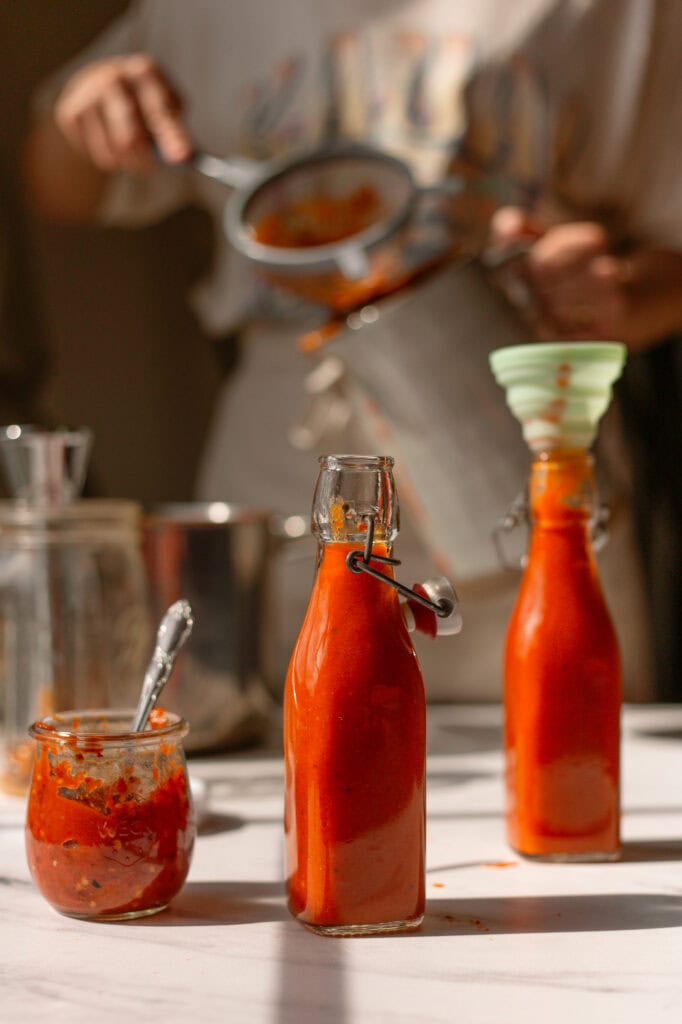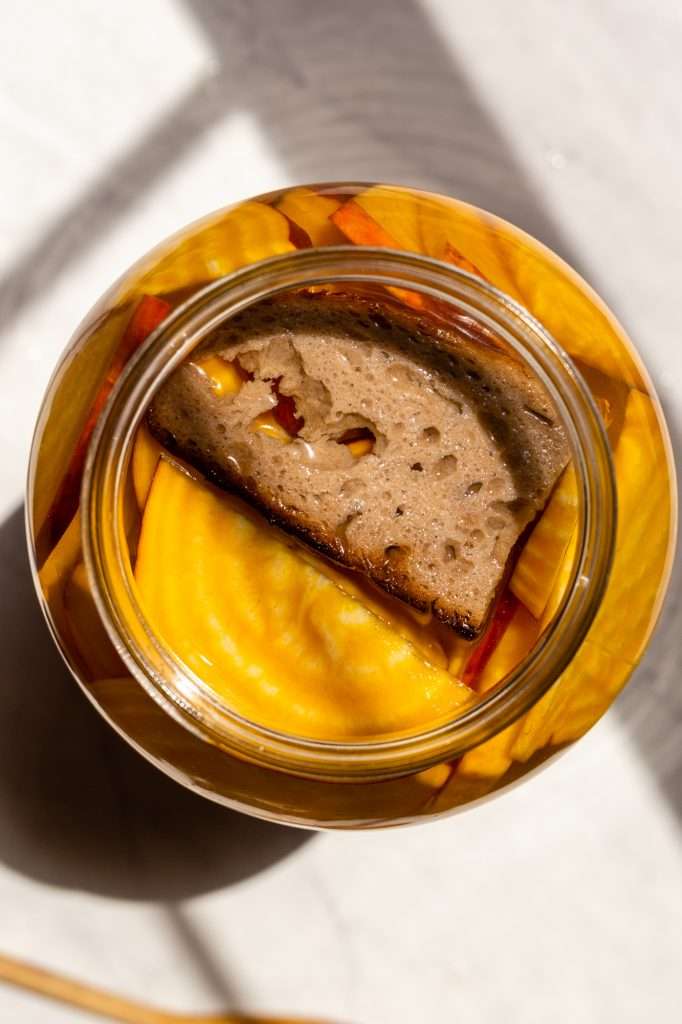Making Lacto Fermented Bok Choy
Bok choy is a Chinese cabbage that is similar in texture to Napa cabbage. Since bok choy and all cabbages grow low and very close to the soil, their microbiome composition is wonderful! This makes all cabbages easy vegetables to ferment, and fermented bok choy is one of my absolute favorites.
It’s important to start with fresh vegetables for this fermentation project. You can use these easy tips to make sure your bok choy is fresh and ready for fermentation:
- Crisp and Snappy: The leaves should be firm and crisp with turgor pressure. When you break off a bok choy leaf, you should hear a “snap.” If the leaves are malleable and you can bend them without snapping, the bok choy isn’t fresh.
- Color: Fresh bok choy leaves have bright white bottoms and vivid green tops. Don’t use bok choy that has yellowing on the green parts of the leaves.
- Start Cold: Before fermenting, store your bok choy in the fridge in a bowl of cold, filtered water. This will help keep the bok choy fresh and crisp.

Fermented Bok Choy Health Benefits
Why is bok choy such a healthy vegetable? It’s part of one of the best groups of vegetables, the Brassica vegetables, which are known for incredible health benefits.
Brassica vegetables contain health-promoting phytochemicals like vitamins, fiber, minerals, glucosinolates, and phenolic compounds.
The beneficial effects of Brassica vegetables on health improvement can be attributed to the complex mixture of antioxidant phytochemicals in these veggies. Many of the polyphenols found in this bok choy help to reduce inflammation and the symptoms of inflammatory conditions.
Let’s dive deeper into those phenolic compounds found in all cabbages. Depending on the structure, polyphenols can be classified into simple phenols, phenolic acids, hydroxycinnamic acid derivatives, and flavonoids.
Phenolic compounds are known to be protective against cancer and heart disease because of their potent antioxidative properties. These polyphenols become more bioavailable and potent through the microbial action of fermentation. Desirable microbes transform plant fiber during fermentation and generate even more bioactive peptides and polyphenols.


Bok Choy Fermented for One Month
The probiotic bacteria in fermented bok choy are very similar to the probiotic bacteria found in fermented green cabbage (sauerkraut). After fermentation, fermented bok choy is loaded with beneficial, gut-health-promoting Lactobacillus species.


Here’s what happens when you ferment bok choy:
- 24 – 48 hours: Ensure all contents in the jar are fully submerged beneath the brine. Some Gram-negative bacteria and opportunistic pathogens may still be present during this period (but do not worry! They will be eliminated). These microorganisms require oxygen, which will gradually be used up in the liquid.
- 48 hours – 10 days: You’ll start noticing plenty of bubbles forming, marking the beginning of stage two in vegetable fermentation. This phase sees the thriving of beneficial Leuconostoc bacteria, gradually displacing all Gram-negative organisms.
- 10-14 days: The bubbles in the brine will begin to lessen as the ferment moves into stage three. The mixture will turn cloudy, change color, and develop a delightful sour aroma, characteristic of thriving Lactobacillus species during this period.
- 14 – 21 days: Lactobacillus species will dominate the microbial community, with Leuconostoc bacteria diminishing. Lactobacillus spp. will start producing abundant lactic acid, enhancing the pleasantly sour scent of the fermented cabbage. This phase signifies the preservation of the vegetable mixture.
- 21 – 28 days: It’s time for a sensory check! Wait until the bok choy reaches your preferred aroma and taste. We like it best when refrigerated around day 25, with its perfectly balanced flavors.
Supplies to Make Fermented Bok Choy at Home

Making Preserved Bok Choy with Fermentation
Burp the Jar
During the first few days of fermentation: carbon dioxide and bubbles will be produced. Sometimes, jars will become very full of liquid, and this liquid can seep out.
- If using a standard mason jar lid: remove the lid and tamper everything back down using a gloved hand, tamper, or spoon. Make sure everything is still submerged below the brine.
Always trust your sense of smell
Fermented bok choy should smell pleasantly sour. Never eat fermented vegetables that smell repulsive or like alcohol.
Never eat anything that has mold growing on it
By following directions and using high-quality, organic ingredients, you should not encounter this problem.
Taste test at three weeks
If you prefer more tart and sour fermented vegetables, let the fermentation proceed at room temperature for up to five weeks.


FAQs
What Temperature Should I Keep My Fermented Bok Choy at?
While fermenting, keep the temperature between 70 and 80 degrees F. Keep out of direct sunlight. After fermentation, keep refrigerated.
How Long Should I Ferment Bok Choy?
After 3 weeks, remove the fermentation weight and do a smell and taste test. Your fermented bok choy should smell pleasantly sour, and it should taste similar to sauerkraut.
Do I Need to Refrigerate Fermented Bok Choy?
Yes. After fermenting for at least three weeks, cover the jar with a regular mason jar lid and refrigerate. Consume within six months for full probiotic benefits.
More Fermentation Recipes to Try
- Homemade Kimchi Inspired Spicy Sauerkraut Recipe
- The Healthiest Lacto Fermented Garlic Recipe
- Fermented Beet and Red Cabbage Sauerkraut

Lacto Fermented Bok Choy with Jalapenos and Shallots
This easy lacto fermented bok choy recipe is perfect for beginners and seasoned fermentation enthusiasts. I love incorporating Jalapenos and shallots for great flavor. Feel free to change it up a bit and use any pepper you want!
- Prep: 10 minutes
- Total Time: 504 hours 10 minutes
Ingredients
- 450 grams bok choy chopped
- 50 grams shallots
- 50 grams jalapeno*
- 20 grams sea salt
- 200 grams filtered water
Instructions
- Wash your fermentation equipment (jar, weight and lid)
- Rinse the baby bok choy with cool water. I prefer to rinse it, chop it, then rinse it again, since it has a lot of folds that can hold dirt.
- Chop the bok choy, peppers and shallots.
- Place your kitchen scale on the counter. Turn it on and set it to weigh in grams.
- Measure out all of your ingredients using your kitchen scale.
- Mix everything, including the water, in a large bowl.
- Pack it all, including the water, into a clean jar with a rust-proof lid. (a 32-ounce jar works best)
- Place a fermentation weight in the jar, secure the lid and allow it to ferment for at least 21 days the refrigerate. You can keep the jar in a glass dish to catch any spills.
- It should get bubbly in the first few days. If you have a tightly secured lid, you will need to burp the jar. You can rinse off the lid and re-adjust the fermentation weight whenever needed.
Notes
- Bok choy sold triple-washed and bagged in grocery stores will have an inadequate microbiome, making it difficult to ferment properly. Use fresh bok choy sold loosely, from the farmers market, or your own garden.
- Don’t like spicy? Sub the jalapeno for bell pepper; it’s delicious! Wan’t it spicier? Try serrano peppers instead of jalapeno.
- This recipe works best with a 32-ounce mason jar.
- I tested the recipe in a 24-ounce weck jar in the photos and it wasn’t quite big enough. But I did try using two tiny weck jar lids as weights, and that worked great with the bigger weck jar lid clipped down holding them down.
Reference Material:



























My store doesn’t carry baby Bok choy . Can I substitute regular Bok choy?
Absolutely! You’ll just want to chop it into pieces since it won’t fit in the jar whole like baby bok choy.
Thanks for sharing! I’m excited to try it! I’m curious about the addition of lemon. In addition to flavor, do the lemon slices serve another purpose?
Emma
No, the lemon is just in there for flavor. But if you add too much lemon with the peel it will develop a soapy flavor. You can leave it out if you’d like.
I started my first batch of this recipe today. Your equipment notes say 16 oz. jar, but I needed a 32 oz. jar and everything just fit. It is also my first attempt at fermentation. I am using silicone fermentation lids. I will let you know how it turns out. I see peppercorns in the photos, do I need to add those? Thanks for posting this article.
My favorite fermentation recipe for fall! I grow bok choy in my garden, so I harvest some while it’s still small and use this recipe to preserve it. I like to add garlic and red pepper, but I leave out the lemon.
You could add something with tannins like a grape leaf or a bay leaf to make them snappy.
Describe amounts in cups and tablespoons as well.
Hi, thank you for the recipe.
I did find the whole recipe page a bit cumbersome and overloaded, including too much detail in the instructions, but maybe that’s just me. So I simply did the usual nearly boiling water (to keep it crunchy) with sea salt (around 10% – the nose knows), bok choi, added a baby red pepper (small, cute and long), a chopped up carrot, some sort of dry chilli which I flaked down with its seeds, along with some pickle mix (coriander, mustard, and other seeds). Gonna see how that works out. Also, I just used a normal jar with the “pop button” in the lid. Been making my pickles like that.
Kudos for the whole venture, good to do and share, and nice having a feedback page.
Thanks for your feedback! This is such an old recipe, from when we were just starting out as bloggers. Our recipe writing style has come a long way, and this one is actually getting an update in the next two weeks!
I am getting to harvest my first baby bok choy of the year so I am excited to try this. Note: when printing the recipe, I chose not to include image and description in the print view, however, both were included in the print view so the entire recipe printed. It’s frustrating when the recipe instructions are split between two pages. (I also chose the smaller print size hoping to get it all one page.)
Glad you’re going to try my recipe! I’ll let our web developers know about the print issue! Thanks for the feedback on that!